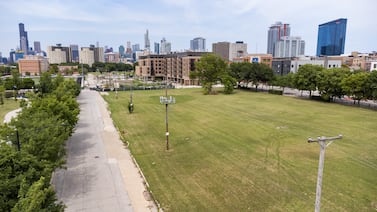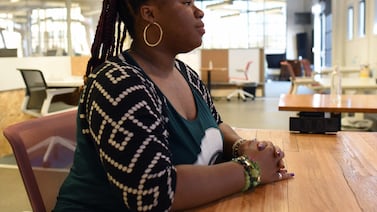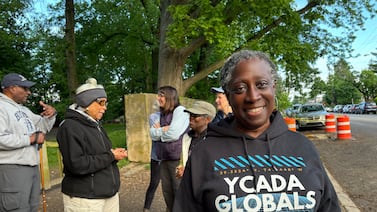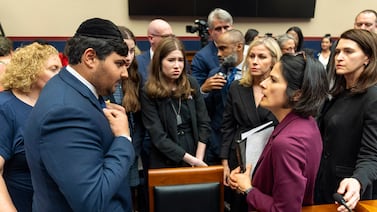Sign up for Chalkbeat New York’s free daily newsletter to keep up with NYC’s public schools.
Katelynn Seetaram, a junior at Pace High School in Manhattan, never had much interest in journalism.
But when she was placed in a journalism class her freshman year, she was stunned at just how much the course could teach her. She learned to question narratives that spread on social media. She developed a stronger sense of media literacy. And she became more skeptical and curious about the stories unfolding around her.
Now, it’s a potential career path that Seetaram hopes to pursue after graduation.
“That one class really led me to what I want to do with the rest of my life,” she said.
Seetaram is just one of the many students, journalists, and educators pushing for others to have the same opportunity. On Thursday, the New York City Youth Journalism Coalition will hold a day of action at City Hall, urging City Council members and other city officials to support more journalism programs across the city’s schools. It’s part of their launch of a “Journalism for All” initiative that includes a newly developed high school journalism curriculum that will roll out in the 2025-26 school year.
The day of action — a collaboration with the Council’s Black, Latino & Asian Caucus — will underscore that many students across the city lack access to high school journalism programs, particularly for students who are Black and Latino. And in the afternoon, Council Member Rita Joseph, who chairs the Education Committee, will introduce a resolution supporting the initiative.
Roughly 73% of the city’s high schools do not have school newspapers or student-run websites, according to a 2022 study by Geanne Belton, a journalism professor and director of the high school journalism program at the City University of New York’s Baruch College.
While more than three-quarters of the schools with the highest concentrations of white and Asian American students had student publications, the same was true for just 8% of schools with high concentrations of Black students and 16% of those with large shares of Latino students, according to the study. Schools with higher rates of poverty were also far less likely to have a student publication.
The inequities mirror trends in the broader industry. A 2018 survey found that journalists of color made up just 22% of the workforce.
“This isn’t only a journalism challenge — this really goes to the heart of civics and democracy,” said Jere Hester, the director of editorial projects and partnerships and acting director of the Local Accountability Reporting program at the Craig Newmark Graduate School of Journalism at CUNY. “What we really want to do is institutionalize journalism instruction in New York City.”
With funding from the Charles H. Revson Foundation, the school has been able to develop a new high school journalism curriculum. The class will teach students the basics of reporting, writing, and producing stories, as well as tackling issues around civics, ethics, misinformation, and more, Hester said. It will also offer opportunities for students to experiment with different reporting mediums, including audio, video, and data journalism. (Revson is supporting a CUNY journalism student summer intern at Chalkbeat.)
Hester hopes students who take the class will be inspired to develop student publications at their high schools — or to participate in ones at schools where they already exist.
“I would love to see all these students become journalists someday,” he said. “Realistically, that’s not going to happen. But we do know that the skills and the inspiration that they get through doing this kind of work at the high school level is going to help them in all kinds of careers.
“Beyond all that, this is a way to help empower students,” he added. “To show them from this age the value of getting involved.”
In the months leading up to the day of action at City Hall, student organizers have been busy reaching out to Council members and raising awareness of the city’s youth journalism gap, said Derry Oliver, a senior at Brooklyn’s Cobble Hill High School.
The hope, she said, is to garner support from Council members and government officials, helping to spread journalism programs to districts and schools across the city. It’s a topic close to home for Oliver, who, despite taking an early interest in journalism, has not had access to a school newspaper.
“One of the things that will make me really happy is to see that other students behind me don’t have to suffer like I have,” Oliver said.
For those without access to journalism classes or publications at their school, the experience can be frustrating.
Fredlove Deshommes, a junior at Brooklyn’s Urban Assembly School for Law and Justice, tried to start a publication at her school, but said her efforts repeatedly stalled due to lack of resources.
Camila Sosa, a junior at Uncommon Collegiate Charter High School in Bedford-Stuyvesant, Brooklyn, said the absence of a student publication at her school has limited her opportunities to explore her interests in journalism and writing — and for students to amplify their voices more broadly.
“It’s insane to me that a lot of kids don’t have the opportunity to use publications as a way to express themselves,” Sosa said. “I hope that what we’re doing here actually makes a change.”
Julian Shen-Berro is a reporter covering New York City. Contact him at jshen-berro@chalkbeat.org.






